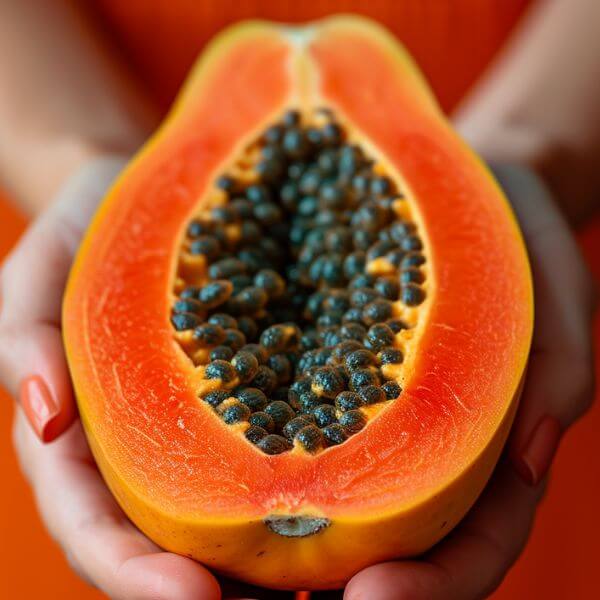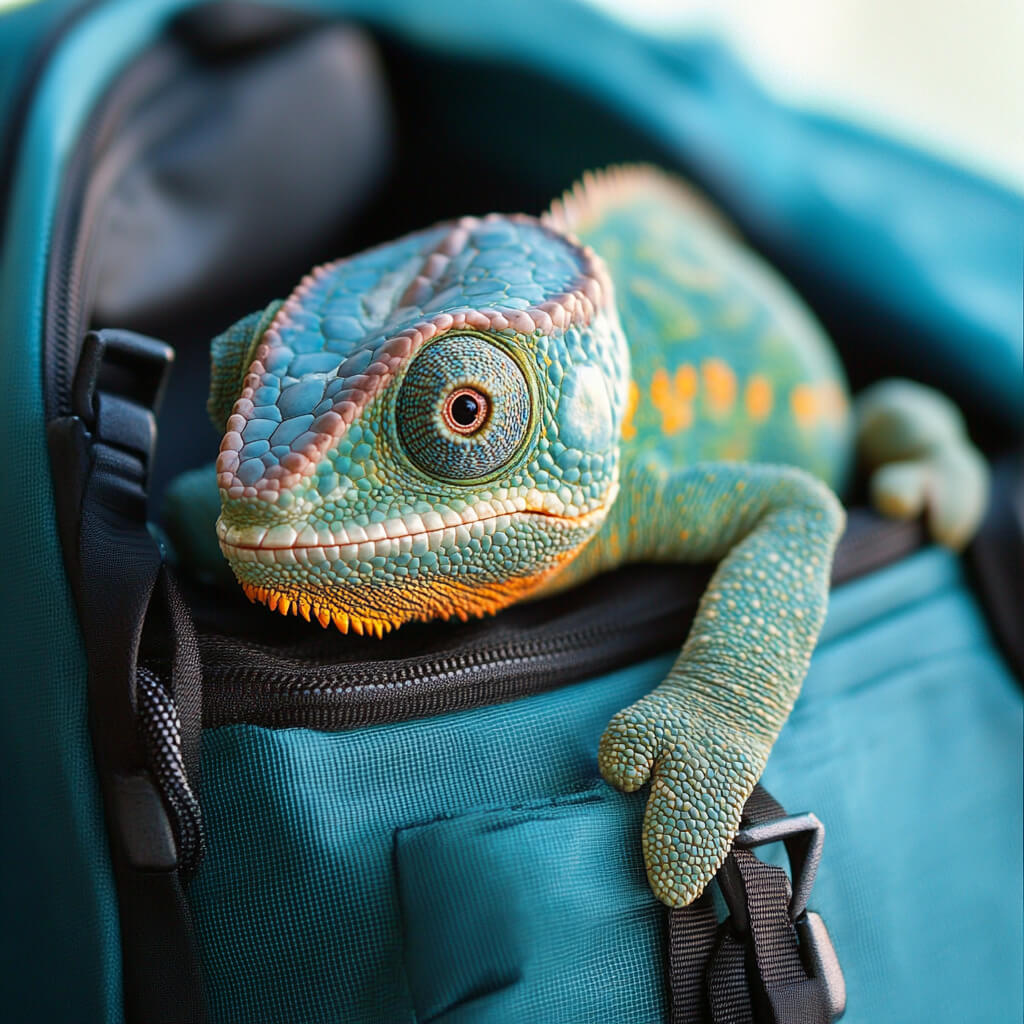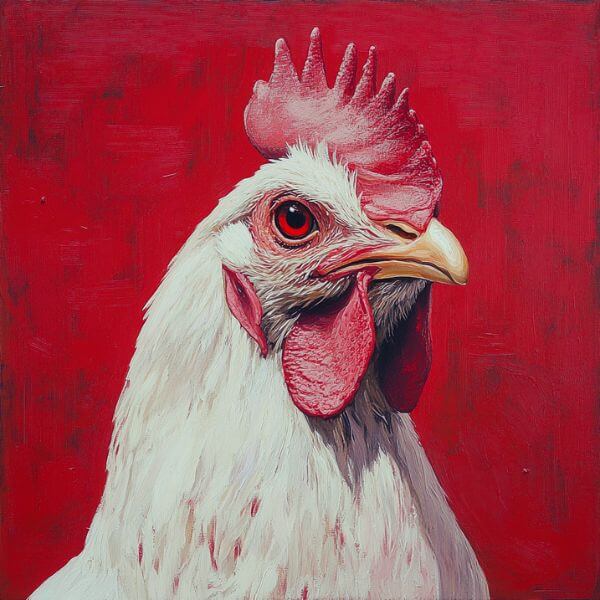Absolutely! Yes, chameleons can eat papaya!
In fact, it’s one of the safe fruits for chameleons when offered in moderation.
Here’s why papaya can be a great addition to your chameleon’s diet:
| Nutrient | Benefit for chameleons |
| Vitamin A | Supports eye health and immune function |
| Vitamin C | Boosts immune system and aids in wound healing |
| Fiber | Promotes healthy digestion |
| Water content | Helps with hydration |
But hold your horses!
Before you go tossing whole papayas into your chameleon’s enclosure, let’s talk about serving sizes and frequency.
Recommended serving size and frequency
- Offer small, bite-sized pieces (about the size of your chameleon’s eye)
- Limit papaya treats to once or twice a month
- Papaya should make up no more than 10% of your chameleon’s overall diet
Remember, moderation is key!
Chameleon diet basics
In the wild, these reptiles are primarily insectivores.
Their natural diet consists of:
- Crickets
- Flies
- Grasshoppers
- Roaches
- Moths
But here’s the thing – captive chameleons can benefit from a more varied diet, including some fruits and veggies.
This is where papaya enters the picture!
Potential risks of feeding papaya to chameleons
While papaya is generally safe, there are a few things to watch out for:
- Sugar content: Papayas are naturally sweet, and too much sugar can lead to obesity and other health issues in chameleons.
- Digestive issues: Some chameleons might have sensitive tummies. Introduce papaya slowly and watch for any signs of digestive upset.
- Nutritional imbalance: Overfeeding fruit can throw off the balance of your chameleon’s diet. Insects should still be the main course!
Pro tip: Always remove any uneaten fruit from your chameleon’s enclosure after a few hours to prevent bacterial growth.
How to safely feed papaya to your chameleon
Ready to treat your chameleon to some papaya? Here’s how to do it right:
- Choose ripe, organic papaya if possible
- Wash the fruit thoroughly
- Remove all seeds and skin
- Cut into small, manageable pieces
- Offer the papaya by hand or place it on a feeding ledge
Keep an eye on your chameleon after introducing papaya.
If you notice any changes in behavior, appetite, or poop (yes, we’re going there), it’s best to consult with a reptile veterinarian.
Alternative fruits and foods for chameleons
Papaya isn’t the only fruit on the menu! Here are some other safe options to mix things up:
- Mango (in moderation)
- Berries (strawberries, blueberries)
- Apple (seedless and skinless)
- Pear (seedless and skinless)
But remember, fruits should be occasional treats.
The bulk of your chameleon’s diet should consist of gut-loaded insects and a variety of leafy greens.
| Food type | Examples | Frequency |
| Insects | Crickets, roaches, worms | Daily |
| Leafy greens | Collard greens, mustard greens | 2-3 times a week |
| Fruits | Papaya, mango, berries | 1-2 times a month |
Maintaining a balanced diet for your chameleon
Alright, let’s talk about the big picture – chameleon nutritional requirements.
These colorful critters need a well-rounded diet to thrive:
- Protein: The main event! Insects provide the bulk of your chameleon’s protein needs.
- Vitamins and minerals: A variety of insects, vegetables, and occasional fruits help cover these bases.
- Calcium: Super important for strong bones. Consider dusting insects with a calcium supplement.
- Hydration: Offer fresh water daily and mist your chameleon’s enclosure regularly.
Chameleon feeding guidelines
Feeding your chameleon isn’t just about what you offer, but also how often and how much.
Here’s a quick guide:
- Adult chameleons: Feed once a day or every other day
- Young chameleons: Feed twice a day
- Offer as many insects as your chameleon can eat in 5-10 minutes
And don’t forget about hydration!
While chameleons get some water from their food, they also need fresh water.
Consider a dripper system or mist the enclosure regularly to mimic their natural environment.
FAQ section
How often can chameleons eat papaya?
Offer papaya as a treat once or twice a month.
Can all chameleon species eat papaya?
While most chameleon species can eat papaya, always research your specific species’ dietary needs.
What parts of the papaya are safe for chameleons?
Only the flesh of the papaya is safe. Remove seeds and skin before feeding.
Are there any signs of papaya allergies in chameleons?
Watch for changes in behavior, appetite, or droppings. If you notice anything unusual, consult a vet.
Can baby chameleons eat papaya?
It’s best to wait until chameleons are at least 6 months old before introducing fruits like papaya.
Conclusion
So, there you have it – chameleons can indeed eat papaya, but it should be an occasional treat rather than a dietary staple.
Remember, a varied diet based primarily on insects is key to keeping your color-changing companion healthy and happy.
Always keep an eye on your chameleon’s reaction to new foods, and when in doubt, chat with a reptile care specialist or veterinarian.
Happy feeding, chameleon fans!
Final thought: Every chameleon is unique, so what works for one might not work for another. Pay attention to your pet’s preferences and health, and adjust their diet accordingly.







Leave a Reply